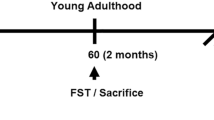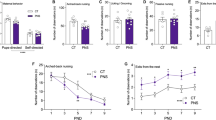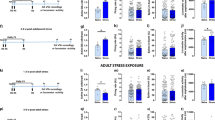Abstract
It has been hypothesized that decreased neurogenesis in the dentate gyrus may be involved in mediating depressive disorders, which are 1.5–3 times more frequent in women than in men. Additionally, prenatal stress may increase the risk of developing depression in adulthood. However, the interrelations between prenatal stress and the development of depression in adulthood, preferentially in females, are not understood. Here, we subjected pregnant rats to a single 20-min period of restraint stress on day 18 after mating. When the offspring were 75 days of age, the numbers of granule cells and pyramidal cells (area CA1–3) in the hippocampus were analyzed with the optical fractionator. The Cavalieri's principle was applied to analyze the volumes of both granule cell layer and pyramidal cell layer in the hippocampus. Prenatally stressed females, but not males, had reduced numbers of hippocampal granule cells compared to their non-prenatally stressed counterparts. This is the first report of a sex-specific difference concerning the reduction of the number of hippocampal granule cells due to prenatal stress. In humans, prenatal stress may induce cell loss in the granule cells of the hippocampus preferentially in females compared to males, and this may be a sex-specific predisposing factor for the development of depression in adulthood.
This is a preview of subscription content, access via your institution
Access options
Subscribe to this journal
Receive 12 print issues and online access
$259.00 per year
only $21.58 per issue
Buy this article
- Purchase on Springer Link
- Instant access to full article PDF
Prices may be subject to local taxes which are calculated during checkout

Similar content being viewed by others
References
Frye CA, Walf AA . Changes in progesterone metabolites in the hippocampus can modulate open field and forced swim test behavior of proestrous rats Horm Behav (in press)
Jacobs BL, Praag H, Gage FH . Adult brain neurogenesis and psychiatry: a novel theory of depression Mol Psychiatry 2000; 5: 262–269
Sapolsky RM . Depression, antidepressants, and the shrinking hippocampus Proc Natl Acad Sci USA 2001; 98: 12320–12322
Manji HK, Drevets WC, Charney DS . The cellular neurobiology of depression Nat Med 2001; 7: 541–547
Watson JB, Mednick SA, Huttunen M, Wang X . Prenatal teratogens and the development of adult mental illness Dev Psychopathol 1999; 11: 457–466
Dugovic C, Maccari S, Weibel L, Turek FW, Van Reeth O . High corticosterone levels in prenatally stressed rats predict persistent paradoxical sleep alterations J Neurosci 1999; 19: 8656–8664
Ustun TB . Cross-national epidemiology of depression and gender J Gend Specif Med 2000; 3: 54–58
Frye CA, Bayon LE . Prenatal stress reduces the effectiveness of the neurosteroid 3 alpha, 5 alpha-THP to block kainic-acid-induced seizures Dev Psychobiol 1999; 34: 227–234
Schmitz C, Bultmann E, Gube M, Korr H . Neuron loss in the mouse hippocampus following prenatal injection of tritiated thymidine or saline Int J Dev Neurosci 1999; 17: 185–190
Gould E, Gross CG . Neurogenesis in adult mammal: some progress and problems J Neurosci 2002; 22: 619–623
Weinstock M . Alterations induced by gestational stress in brain morphology and behaviour of the offspring Prog Neurobiol 2001; 65: 427–451
Rapp P, Gallagher M . Preserved neuron number in the hippocampus of aged rats with spatial learning deficits Proc Natl Acad Sci USA 1996; 93: 9926–9930
Lemaire V, Koehl M, Le Moal M, Abrous DN . Prenatal stress produces learning deficits associated with an inhibition of neurogenesis in the hippocampus Proc Natl Acad Sci USA 2000; 97: 11032–11037
Gould E, Cameron HA, Daniels DC, Woolley CS, McEwen BS . Adrenal hormones suppress cell division in the adult rat dentate gyrus J Neurosci 1992; 12: 3642–3650
Czeh B, Michaelis T, Watanabe T, Frahm J, de Biurrun G, van Kampen M et al. Stress-induced changes in cerebral metabolites, hippocampal volume, and cell proliferation are prevented by antidepressant treatment with tianeptine Proc Natl Acad Sci USA 2001; 98: 12796–12801
Schmitz C, Hof PR . Recommendations for straightforward and rigorous methods of counting neurons based on a computer simulation approach J Chem Neuroanat 2000; 20: 93–114
Acknowledgements
We thank H Helten for technical assistance, and BPF Rutten for help in generating Figure 1. This work was in part supported by a grant of the START program of the Faculty of Medicine of the RWTH University of Aachen (to CS), and by the US National Science Foundation (IBN98-96263 and DBI-0097343, to CA Frye).
Author information
Authors and Affiliations
Corresponding author
Rights and permissions
About this article
Cite this article
Schmitz, C., Rhodes, M., Bludau, M. et al. Depression: reduced number of granule cells in the hippocampus of female, but not male, rats due to prenatal restraint stress. Mol Psychiatry 7, 810–813 (2002). https://doi.org/10.1038/sj.mp.4001118
Received:
Revised:
Accepted:
Published:
Issue Date:
DOI: https://doi.org/10.1038/sj.mp.4001118
Keywords
This article is cited by
-
BDNF effects on dendritic spine morphology and hippocampal function
Cell and Tissue Research (2018)
-
Prenatal noise stress impairs HPA axis and cognitive performance in mice
Scientific Reports (2017)
-
Effects of postnatal hyperoxia exposure on the rat dentate gyrus and subventricular zone
Brain Structure and Function (2015)
-
Chronic agomelatine treatment corrects behavioral, cellular, and biochemical abnormalities induced by prenatal stress in rats
Psychopharmacology (2011)



